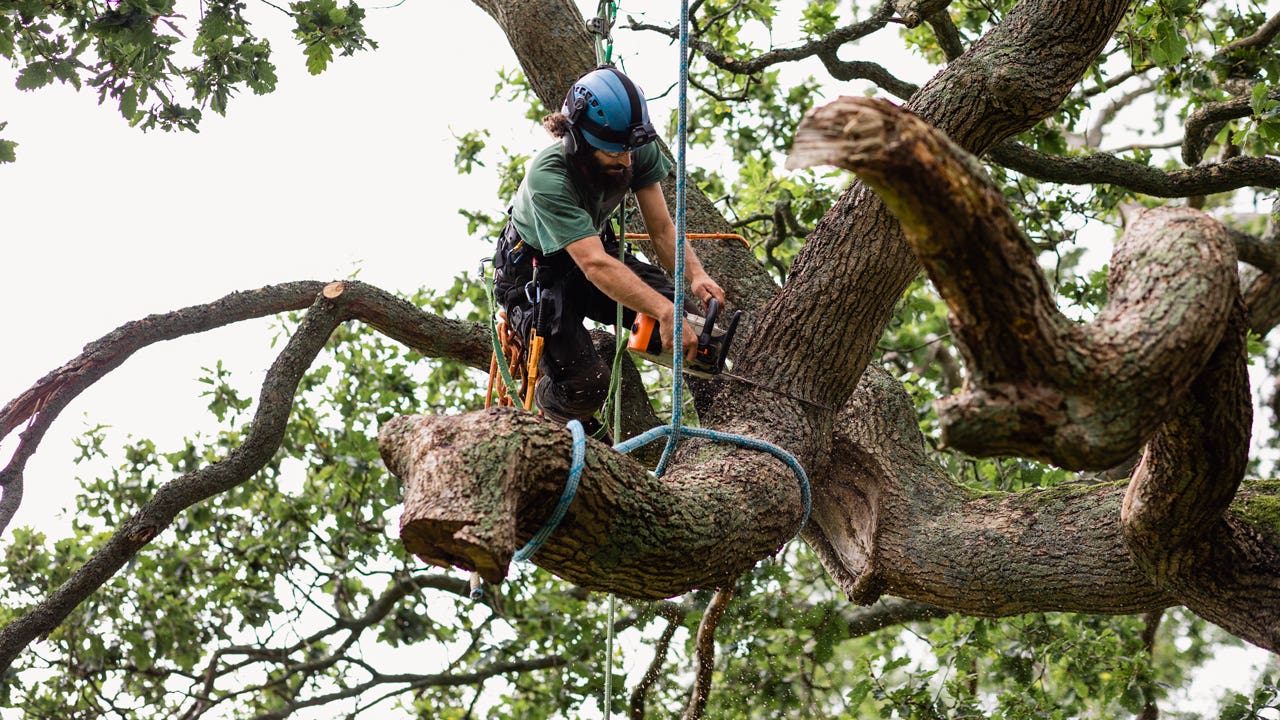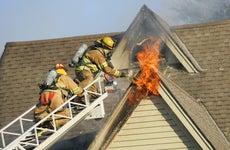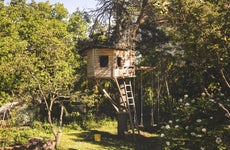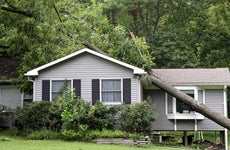Will my homeowners insurance policy cover tree removal?

The Bankrate promise
At Bankrate, we strive to help you make smarter financial decisions. To help readers understand how insurance affects their finances, we have licensed insurance professionals on staff who have spent a combined 47 years in the auto, home and life insurance industries. While we adhere to strict , this post may contain references to products from our partners. Here's an explanation of . Our content is backed by Coverage.com, LLC, a licensed entity (NPN: 19966249). For more information, please see our .
Key takeaways
- Home insurance may cover tree debris removal in some scenarios, such as after a windstorm or ice storm, but only up to your policy’s coverage limits.
- Your policy likely won’t pay to remove a dead, rotted, overgrown or potentially damaging tree from your property.
- If one of your trees falls onto a neighbor’s home, the neighbor’s insurance will likely respond.
While established trees may be a draw when house shopping, they can also cause damage to your property. Regular tree maintenance isn’t typically covered by home insurance, but damage from trees that occurs during a storm or other covered peril may be eligible for coverage. Bankrate’s insurance editorial team breaks down the ins and outs of tree removal coverage to help you manage your property’s green space.
Does homeowners insurance cover tree removal?
Home insurance covers tree damage and tree removal in certain scenarios. Generally, if a tree or limb falls onto your home, onto a detached structure like a garage or shed or is blocking your driveway, insurance could cover the removal up to your policy limit. However, the reason that the tree falls is important. Removal may be covered if a tree falls under the following scenarios — but only if it falls on your home, an outbuilding or your driveway:
- Windstorm
- Hail storms
- Under the weight of ice or snow
- Lightning and the resulting fire
- Other covered perils listed in your policy
Keep in mind, though, that all policies are different. You may want to talk to your agent about the specifics of your policy to better understand what’s covered.
How can trees damage my property?
While having trees on your property can be aesthetically pleasing, trees do come with maintenance costs and can even cause damage to the home in a number of ways, including:
- Damage to roofs: Tree limbs that overhang your home can be knocked down during storms, damaging your roof and even falling into your house.
- Damage to siding: Limbs can also blow into your siding or repeatedly rub against your home and cause scratching or deeper damage.
- Interior water damage: If a tree limb or an entire tree has fallen onto or against your house during a storm, you may have rain coming inside, which can cause interior water damage.
- Damage to service lines: The roots of your trees can grow into service lines, like your water or gas lines, and cause damage.
- Blocked driveways: If a tree falls across your driveway, you may need to have it removed to get your vehicles out.
When does homeowners insurance not cover tree removal?
Not all tree removal scenarios are covered by standard home insurance. Your home insurance company could deny removal coverage if a tree falls in the following situations:
- During a flood
- During an earthquake
- If the tree is dead
- If the tree is rotted
- If the tree is not well-maintained
Will homeowners insurance cover preventative tree removal?
Further, you may wonder if homeowners insurance covers preventative tree removal. Most often, the answer is no. These scenarios are considered maintenance and are part of the cost of having trees on your property. Tree-related debris or damage after a storm may be covered, though.
If a specific tree is posing a threat — say to a utility line or structure on your property — you can look into hiring a tree removal professional before any damage is incurred. The good news is, in many cases, the cost of removal may be less expensive than your home insurance deductible.
Will my home policy cover tree damage that occurs to my neighbor’s house?
Not usually. If a tree on your lot falls onto your neighbor’s home due to a covered peril, your neighbor’s home insurance policy is generally going to help pay for the damage. Your home policy likely doesn’t cover damage to your neighbor’s house, regardless of whose tree falls.
The only way that your policy may kick in is if you are found liable for the damage. If you know that a tree is dead, rotted or otherwise compromised and that it poses a threat to your neighbor’s home, but you do not act to remove the tree, you may be found negligent. Your neighbor could sue you to prove your negligence and ask for the damage to be paid for.
How to protect your home from tree damage
When it comes to trees already established on your property, regularly inspecting and maintaining them may be your best course of action for preventing damage or injury. This may include:
- Removing dead or overgrown limbs and trees
- Hiring a professional to help trim around power lines on a routine basis
- Monitoring and addressing root systems that could interfere with underground pipes or wiring
When planting new trees on your property, you may want to choose a species that is weather-tolerant for your area. You can also position new trees strategically so they are less likely to interfere with structures or systems already established on the property.
How much does it cost to remove a tree?
The cost to remove a tree depends on several factors, but you could expect to pay anywhere from $200 to $2,000. Shorter trees are easier to remove and may cost less. However, tall trees — typically any tree over 50 feet — might cost significantly more to remove. Tree removal companies will usually measure the height and diameter of the tree in question and provide you with a quote before beginning the project.
Keep in mind that other factors can affect the cost of tree removal, too. These could include:
- Accessibility: Expect to pay more if the tree is in a hard-to-reach spot or close to power or utility lines. You might also pay more if the workers have to clear brush or plants near the base of the tree.
- Location: Tree removal costs can vary by region, and tree removal companies often have a service area that they work within. If you live outside of a service area, you might face steeper costs.
- Health of the tree: Dead trees might cost less to remove since they’re lighter and their bark is often softer. Plus, if the dead tree has already fallen, most companies won’t charge as much to simply haul it away. However, diseased trees could be more expensive to remove if the company has to prevent the disease from spreading to healthy trees nearby.
- Number of trunks: Trees with multiple trunks or a wide diameter usually cost more because they are more difficult to remove.
- Emergency removal: You might pay the most for tree removal if it’s an emergency, like after a storm. This is because tree removal might be in high demand in your area. It’s also more likely that if it’s an emergency removal, the tree in question is positioned poorly — on a power line, on your roof or in traffic, for instance — which can drive up removal costs.
Don’t forget that you may also be charged for stump removal or wood chipping once the tree is down. If desired, some tree removal companies might offer to chop the wood into firewood for you for a fee.
Frequently asked questions
-
-
Home insurance is designed to cover sudden and accidental damage. If you have a dead tree on your property, the damage caused by the tree is not necessarily sudden. You know that the tree could fall and cause damage, and it is your responsibility as a homeowner to protect your property. Maintaining the health of the trees on your property, which includes removing any trees that pose a threat to your home, is part of home maintenance.
-
In general, there are a few signs that a tree could fall on your house and damage it. For starters, if there are trees in your yard that overhang your roof or if there are trees that have branches that hang near your home, you could be at risk of trees or limbs falling onto your house. Furthermore, any large trees that sit near your home and are large enough to collide with your home if toppled by wind could also pose a risk. The general rule is that you want your yard to be free from trees that sit too close to your home, and the area around your house should be relatively clear from trees to mitigate the risks. If you’re unsure about the health of a tree in your yard, you can ask for an evaluation from a landscaper or tree professional.
-
It depends on your policy. Many standard policies include $500 to $1,000 in debris removal coverage, although some companies may consider debris removal coverage to be a percentage of your overall loss. For example, if a tree falls and causes $5,000 in damage to your home and you only have 5 percent debris removal coverage, your policy may pay up to $250 to remove the tree. You might be able to increase this amount depending on your policy type and carrier. If you have several trees or particularly large trees on your lot, you may want to consider increasing your coverage.
-
Related Articles



